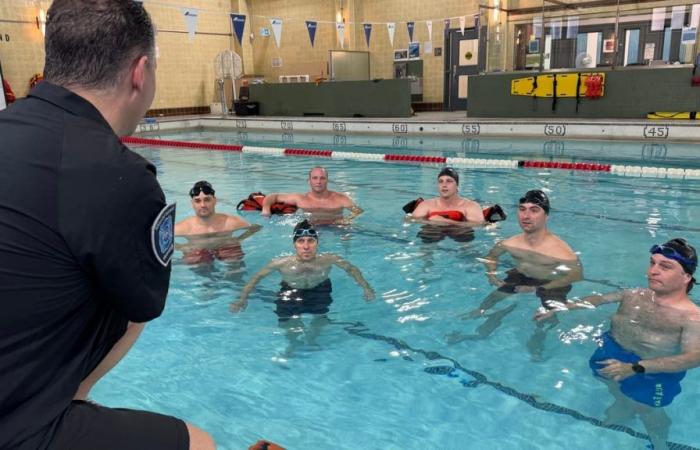The Montreal Fire Safety Service (SIM) has learned lessons from a tragic event which cost the life of one of its own and has launched training with the Quebec Rescue Society so that firefighters can intervene safely and more effectively on the bodies of water on the island.
“The only ones who had training that was truly aquatic were the Sûreté du Québec police officers transported by helicopter,” explains the general director of the Société de rescue du Québec (SVQ), Raynald Hawkins.
Before today, SIM firefighters did not have optimal and uniform training in nautical intervention. Each fire station trained its own responders. The Société de secours du Québec and SIM have launched what is called self-rescue training.
“If we want our staff to be able to improve the safety of citizens around the island of Montreal who enjoy bodies of water, we must first ensure their safety, then allow them to feel safe. In the worst case scenario, it’s a firefighter who falls into the water,” explains Steve Rillart, division head of specialized operations at the Montreal Fire Department.
In response to the death of Pierre Lacroix
The program was developed in response to the recommendations of coroner Géhane Kamel after the death of Pierre Lacroix. On October 17, 2021, the 58-year-old firefighter died during a rescue operation on the St. Lawrence River.
Photo Agence QMI, MARIE-LAURENCE DELAINEY
Montreal firefighters are undergoing new training in water rescue. Here we see colleagues simulating wave movements with training boards around a firefighter who is trying to pull towards the edge. June 26, 2024.
The QMI Agency attended a training day which took place in two stages, indoors and outdoors. During our visit, nearly a dozen firefighters were conducting exercises in a swimming pool to test their comfort in the water and refine their swimming techniques. For example, colleagues simulated wave movements with training boards around a firefighter who was trying to pull towards the edge with a rope. Others practiced rescuing a dummy underwater while wearing their life jackets.
Photo Agence QMI, MARIE-LAURENCE DELAINEY
Montreal firefighters are undergoing new training in water rescue. Here they are seen practicing rescuing a dummy underwater while wearing their life jackets. June 26, 2024.
«[La formation] represents the different levels of risks that exist on the bodies of water around Montreal. A swimming pool is a controlled environment…After that, we go to the Great Lakes, where we don’t touch the bottom, we go to beaches where there is current, rivers are environments that are uncontrolled,” adds Mr. Rillart.
Photo Agence QMI, MARIE-LAURENCE DELAINEY
Montreal firefighters are undergoing new training in water rescue. We see them here practicing how to keep their boat in place despite the current. June 26, 2024.
Firefighters must therefore also practice in white water on bodies of water. We attended part of the training on the St. Lawrence River aimed at keeping the new SIM boats in place near a buoy. “We see the driver doing a protocol to keep control of his boat as if he were approaching a victim. One of the skills that is required is to approach an obstacle, keep the boat in control at all times, the speed of the boat in the current,” describes Mr. Rillart.
Marie-Laurence Delainey Agence QMI
The two firefighters Alexandre Roy and Claude Montpetit are taking training as nautical rescue technicians from the SIM. June 26, 2024. Marie-Laurence Delainey QMI Agency
Prevention posters will also be installed in the 28 places where Montrealers have access to water. Each will indicate the risks present as well as safety instructions.
Image provided by SIM
“At the start of the holidays, we’re going to want to be near the water, on the water and in the water. With the SIM, we’re going to be able to react quickly and intervene if ever it’s necessary,” concludes Mr. Hawkins.
Ultimately, nearly 300 Montreal firefighters will be trained. The training lasts 24 hours, but also includes a shortened 12-hour version for other responders, such as police officers, rescuers or other first responders. The Quebec Lifesaving Society wishes to offer it across the country.






